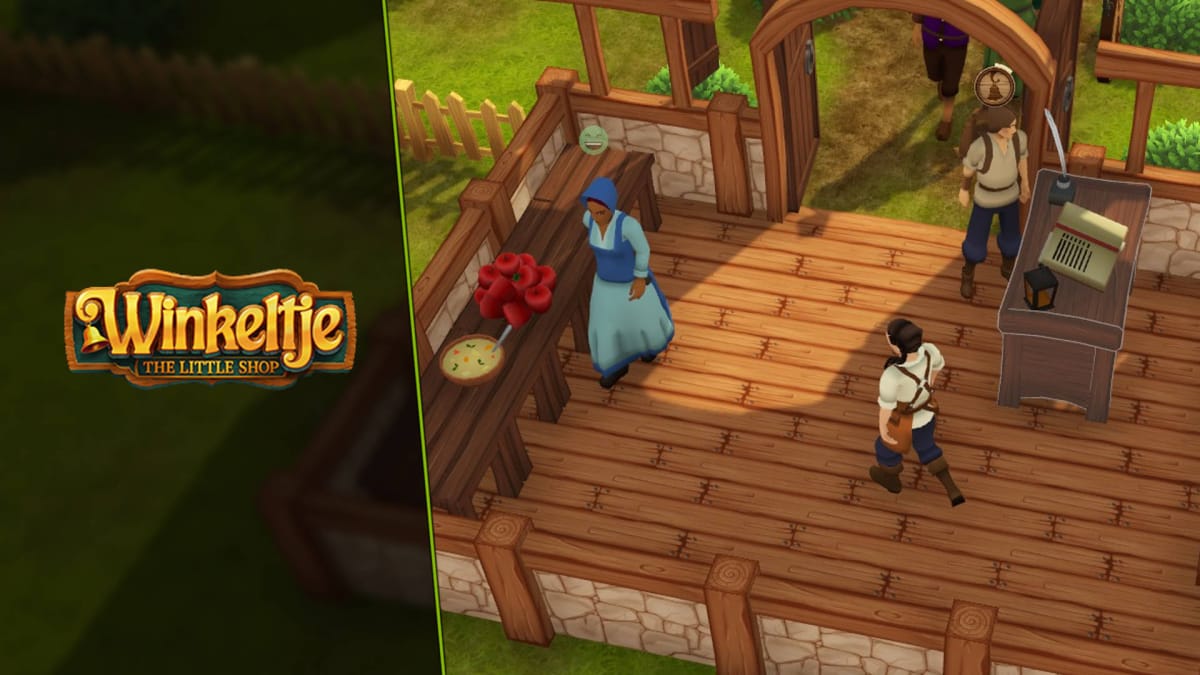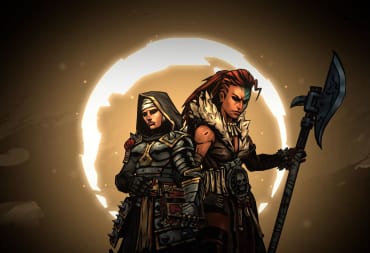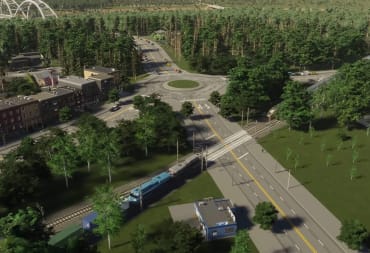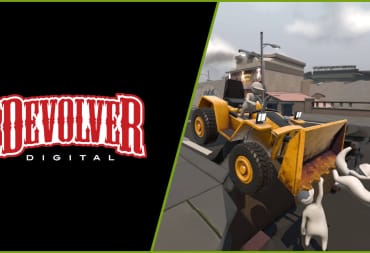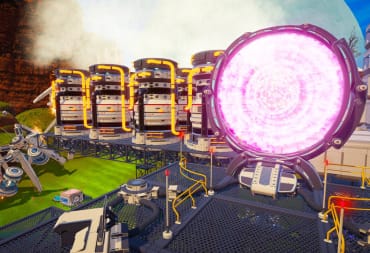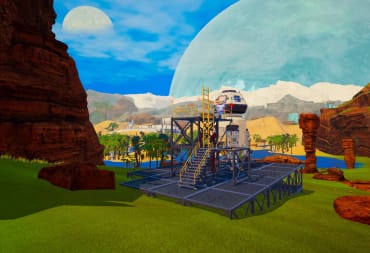In this Winkeltje: The Little Shop Guide for Beginners, I'll tell you what you need to know to succeed in this shopkeep simulator!
Winkeltje Guide for Beginners - Game Mechanics You Need to Know
The first part of this Winkeltje: The Little Shop Guide for Beginners will cover the game's mechanics. There are a lot of moving parts here, but it's not too difficult to understand once you get into the swing of things!
Money (Silver)
As a shopkeeper, your world revolves around money. You'll need it to buy stock, item Displays, and Decorations. You'll also need it to pay down your debt in most game modes.
Debt
Debt is a game mechanic in most difficulty levels. You have to pay either at the start or the end of the day it's due. If you can't pay it, you'll lose the game. (Make sure to save regularly!)
Objectives
Objectives give you an idea of what you should be doing next. Completing some Objectives will give you tangible in-game rewards or unlock new cosmetics.
Level
Level is your overall progress with the game. You'll unlock more items to sell, shop Displays, and Decorations as you increase your Level.
Appeal
Appeal is, well, a measure of how appealing your shop is to customers. A higher Appeal score attracts more customers. You can increase Appeal by placing Decorations and Displays.

Season
The world of Winkeltje goes through Seasons, just like the real world. Seasons will affect the prices of some items by either raising or lowering them.
Events
Events are limited-time events that will affect the game in some way, such as by increasing demand for an item or raising/lowering prices for one or more items.
Buy
The Buy button allows you to purchase shop Displays and Decorations. You can resell them for the exact same amount of money you purchased them for.
Build
The Build button lets you expand your shop or change its look. You can sell whatever you buy for the same price you paid for it.
Counter
The Counter serves three purposes:
- It's used to order items for selling or crafting.
- Traveling Traders will stop and wait here.
- Customers will wait here if they want to buy an item but you don't have it in stock.
- Both Traders and Customers will only wait for a short period of time before leaving. You can also click on the Trader or Customer and immediately Dismiss them if you'd like.
Inventory
Your Inventory is all of the items you currently own. You can see the list of owned items on the top left of the screen.
Displays & Tables
You need at least one Display to sell items and a customer must be able to walk to it in order to buy the item. Items placed on a Display free up space in your Inventory.
Storage
Storage objects will increase your Inventory space.
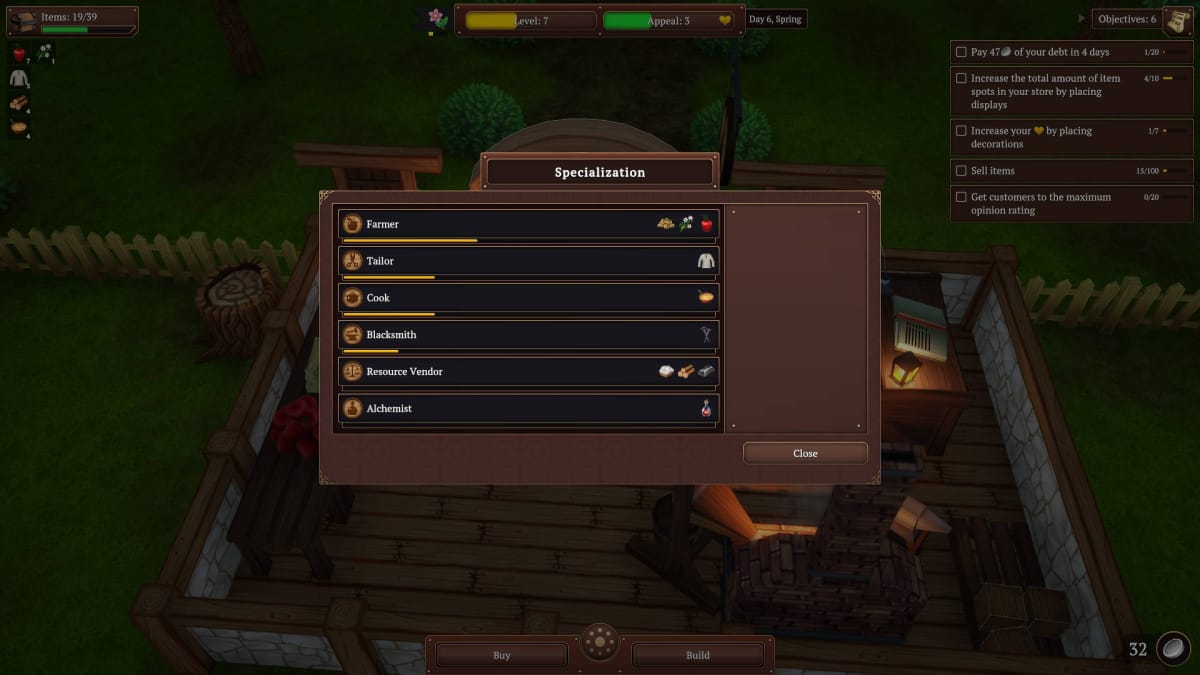
Specialization
'Specialization shows what customers expect you to carry in your store, based in part on what you've sold in the last several days. If you're only selling Apples, for example, customers are going to want to buy more Apples and similar items.
Unlocks
The Unlocks screen shows all of the items you can unlock in the game. Most items are unlocked by reaching a certain level; a notable exception is certain Crafting stations.
Crafting Skill Points
Crafting Skill Points are used to unlock Crafting stations (such as the Forge) in the Unlock menu.
Days and Time
When you open your shop by clicking on the doors, you will have a limited amount of time to sell items to customers. This is represented by a spinning sky icon on the UI. Once a day is over, the shop will automatically close.
Traders
Traders will occasionally stop by the Counter and offer to sell you items. These items are sometimes at better prices than what you could normally order from the Counter.
Crafting
Crafting can be done once you unlock certain Crafting stations. Crafting can be highly profitable; items you Craft from raw materials will have a higher profit margin than if you purchased the items wholesale.
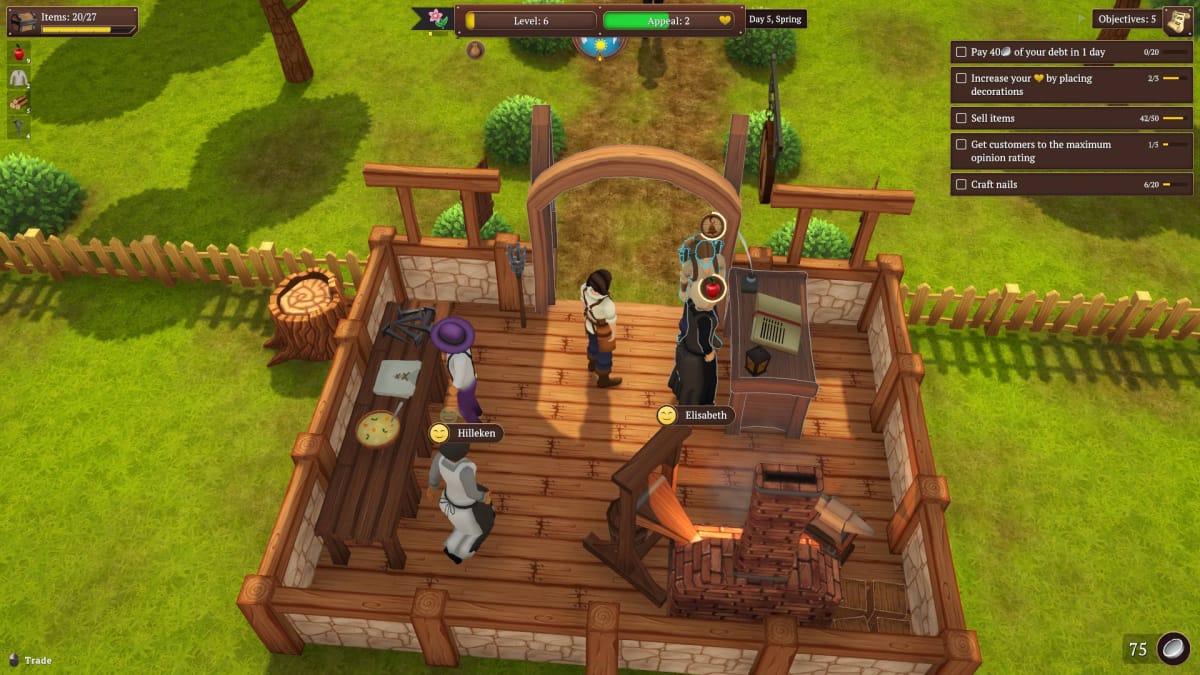
How to Play Winkletje: The Little Shop
Now that you've got the mechanics down, the next part of our Winkeltje: The Little Shop Guide for Beginners will cover your first few days in-game.
Start a New Game and Select your Difficulty & Scenario
Your first step, naturally, is to start a new game. Before you play, you'll need to select your difficulty and choose your scenario. I'd recommend Normal difficulty and the Large Shop for your first playthrough unless you're unfamiliar with this genre -- if you've never played a game like this before, it might be best to start on Easy or Relaxed first.
Difficulties
- Relaxed
- The easiest way to play. You can not go bankrupt.
- No debt
- More profit from [high-quality] items
- Items are less expensive
- Faster crafting
- More stock capacity
- Longer days, same customers
- Easy
- Some challenge. You could go bankrupt.
- Lower debt
- More profit from [high-quality] items
- Items are less expensive
- Faster crafting
- Longer days, same customers
- Normal
- The recommended shopkeeping experience.
- A balanced experience
- Hard
- A real shopkeeping challenge.
- Higher debt
- Less profit from [high-quality] items
- Items are more expensive
- Slower crafting and less experience
- Lower stock capacity
- Very Hard
- Requires a deep understanding of the game.
- Even higher debt
- Less profit from [high-quality] items
- Items are more expensive
- Slower crafting and less experience
- Lower stock capacity
- More expensive storage
- Shorter days, same customers
- Creative
- Everything is free. Build the shop of your dreams.
- No debt
- Free furniture
- Free expansion
Scenarios
- Default
- A normal plot of land.
- 12x12 tiles
- Large Shop
- A large plot of land.
- 16x14 tiles
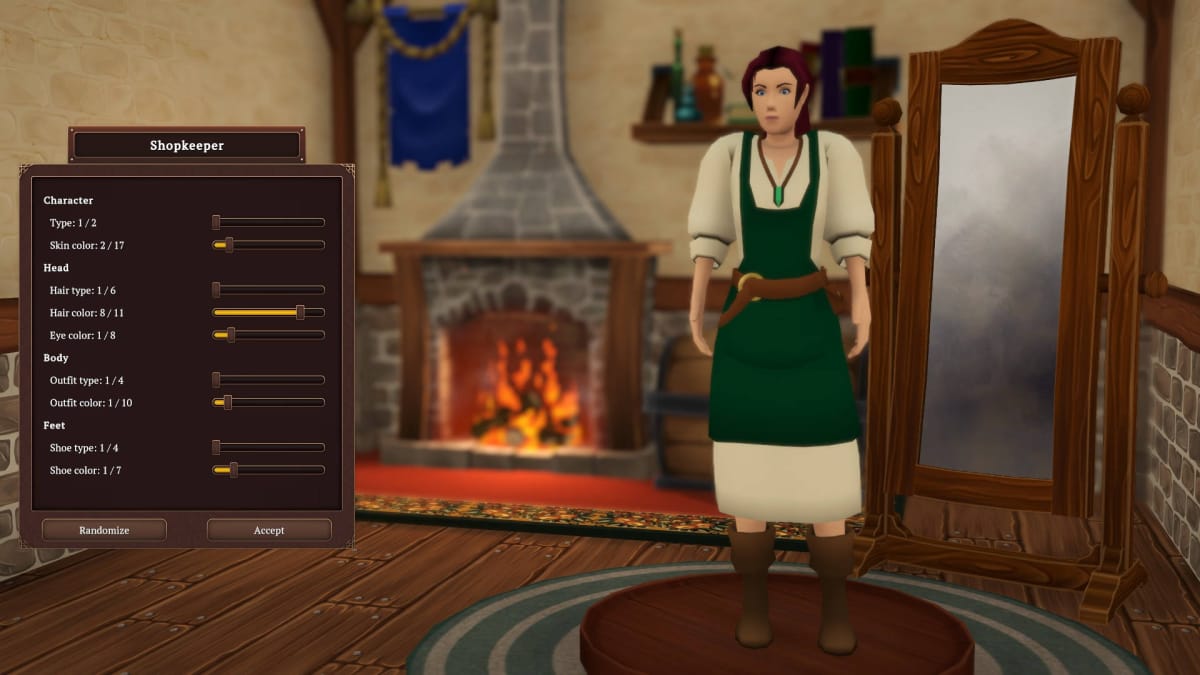
Create Your Character
Your next step is to create your character. You can make your shopkeeper a man or woman and you have a fair number of cosmetic options available, although some of them will have to be unlocked in the course of playing the game.
Setting Up Your Shop
Now that you've created your character, it's time to set up your shop! You don't have very much money, nor are there many items available for purchase just yet.
First, we're going to start with the Counter. This is where Customers will stand when they're looking for an item or when they want to pay. This is also where Traders will stop by when they come in during the day. Finally, the Counter is used to order more items.
Next, we're going to start with tables. Buy 3 of the cheapest Displays you can in order to display items for sale. Then, you should buy 3 Vegetable Soups, 3 Shirts, and as many Apples as you can afford by using the Counter. Put one of each item on a table, then replenish your stock once again. Now, it's time to open for business!
Opening Your Shop
Click on the doors to open your shop. Customers will come in and purchase items by taking them from a Display. You'll have to walk to the Display and left-click on it to replace the item. Don't take too long -- you're on the clock!
Continue selling items until the day is over. If you run out of something, you can order it from the Counter during the day. However, you'll have to wait a short time for it to be delivered -- it won't arrive instantly like at nighttime.
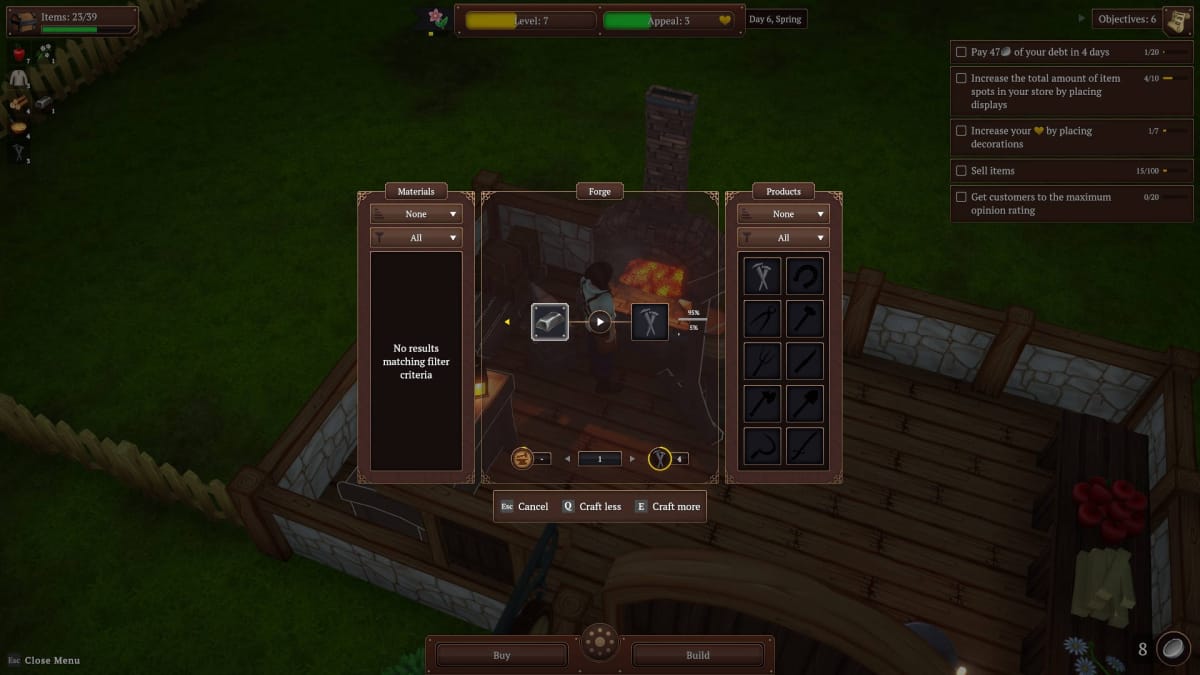
Start Crafting
After a few in-game days, you'll be able to begin Crafting. Whichever method you choose, you'll be able to sell crafted items for a better profit margin. Just take care not to run out of raw materials!
Pay Down Your Debt
Continue selling items and completing Objectives until you get to your first due date for your debt. When the day arrives, you can pay it in the morning or at the end of the selling period. If you fail to pay your debt, you'll lose the game.
Once you've made your first payment, the next debt payment will increase and you'll have a few days before you have to pay it again.
Expand Your Inventory with Storage
Purchase a Pallet as soon as you can so you can expand your Inventory. If you can store more items, you can sell more items.
Stockpile Items
Here's an important tip -- it's a good idea to stockpile a good amount of items. I recommend holding onto at least 10 of an item if possible. Events may increase the price of certain items, and a solid stockpile will help you avoid losing money due to increased costs.
Expand Your Shop
Your final goal in this Winkeltje: The Little Shop Guide for Beginners is to expand your shop. Add a few floor tiles and make good use of the extra room, either by adding more Storage items or placing more Displays.
Continue Your Shopkeeping Adventure
Once you've completed all of these steps, you've pretty much got the game down. From here, your focus should be on making your debt payments. Once your debt is cleared, you can move on to making the most out of your shop. Have fun!

Winkeltje: The Little Shop F.A.Q.
What is Winkeltje: The Little Shop?
Winkeltje: The Little Shop is a shopkeeping simulator developed and published by indie developer Sassybot.
Is Winkeltje Multiplayer?
No, Winkeltje: The Little Shop is not multiplayer.
What Does 'Winkeltje' Mean?
"Winkel" means "shop" in Dutch and "je" is a diminutive modifier, so "Winkeltje" means "little shop." And yes, that means the game's name is technically "Little Shop: The Little Shop."
Have a tip, or want to point out something we missed? Leave a Comment or e-mail us at tips@techraptor.net
